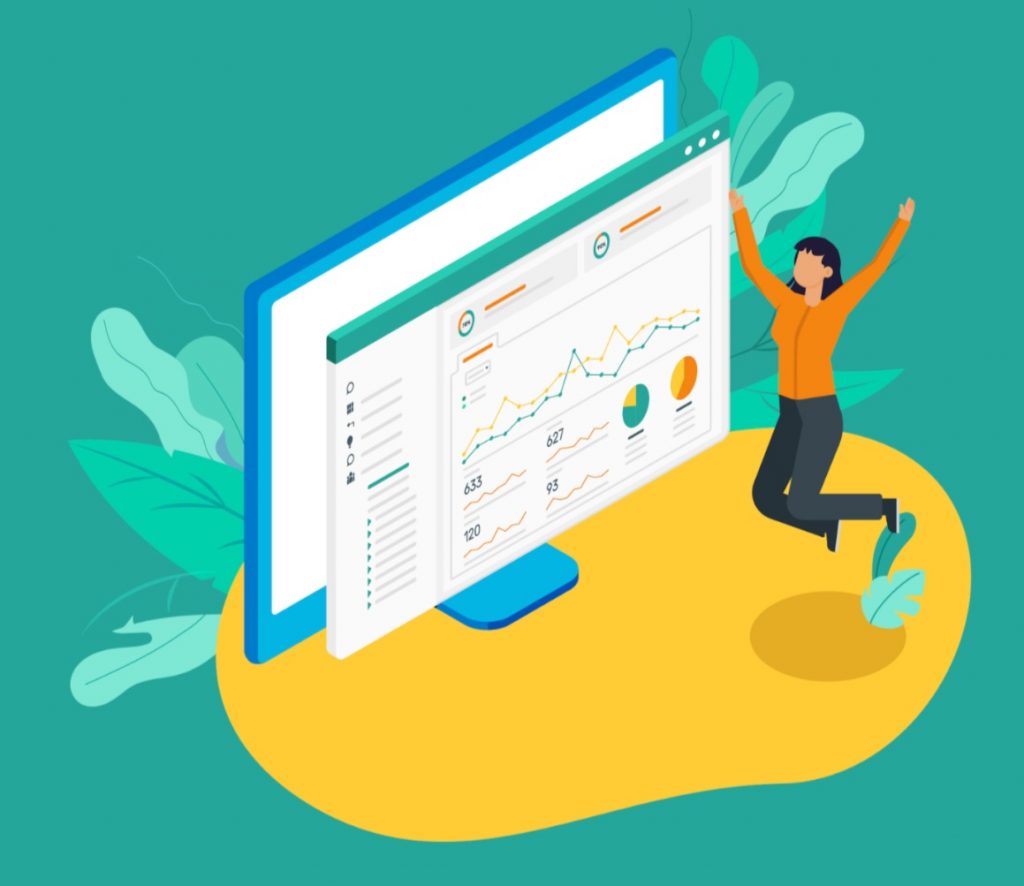Accelerating Advancement of Diverse Talent With People Analytics & Organizational Network Analysis
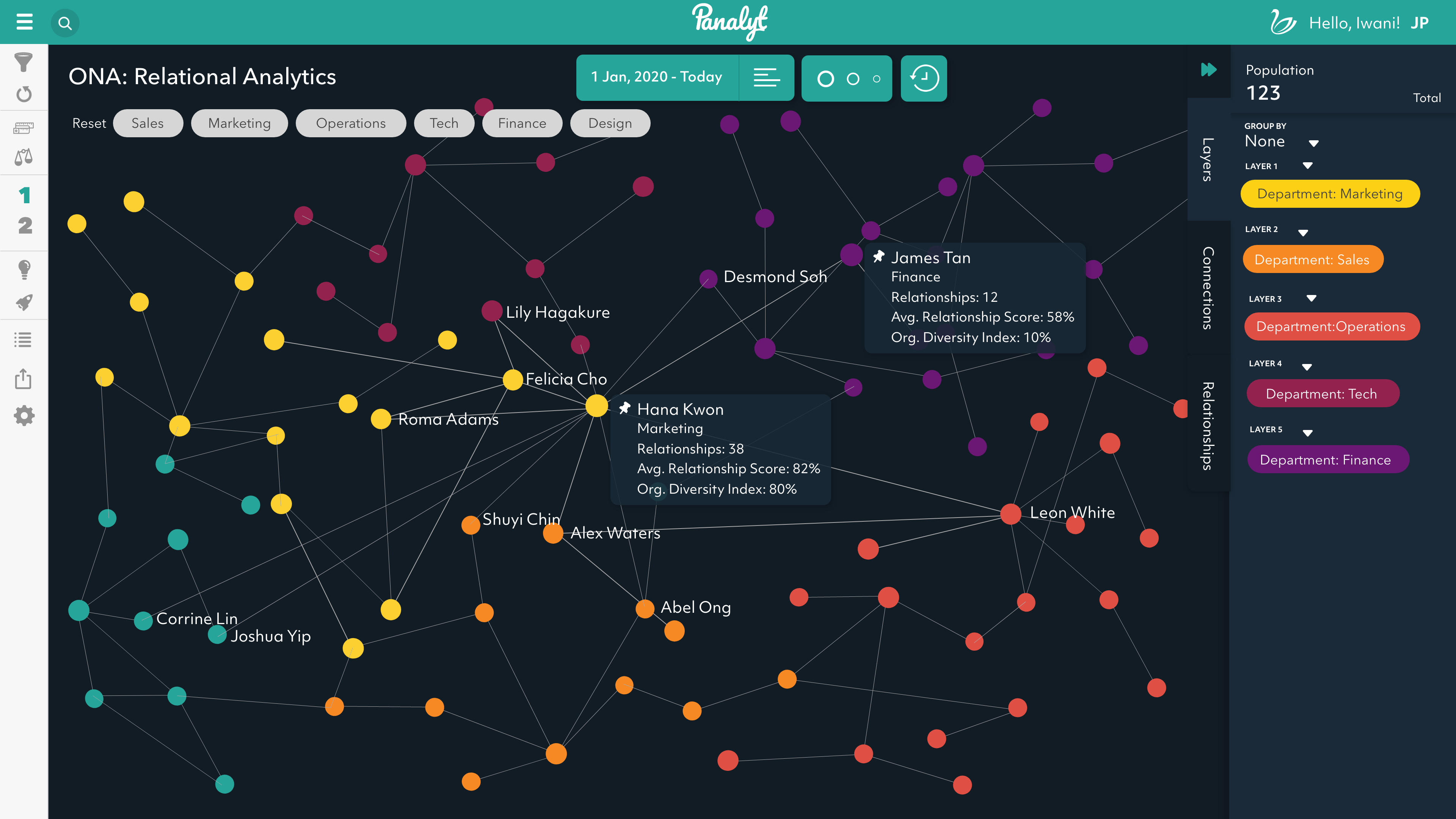
This article is an executive summary of Panalyt’s webinar “People Analytics: Diversity & Career Growth”, which covered how companies can accelerate the advancement of diverse talent by leveraging People Analytics and Organizational Network Analysis to identify WHERE you need to intervene to ensure the success of your DEIB programs, coupled with practical advice on HOW you should intervene to drive results.
All Panalyt webinar recordings and slides are now available at the Panalyt People Analytics Learning Hub.
The Panalyt team also thanks Grace Ho from Liminal Space Coaching and Development (previously Head of Diversity & Inclusion for McKinsey Asia-Pacific) for contributing her insights!
Note: While there are nuanced differences between Organizational Network Analysis(ONA) and Relational Analytics( ONA + People / Productivity data + a clear focus on measuring the relationship strength between individuals in addition to digital collaboration analytics), the terms have been used interchangeably in this guide.
Key Takeaways From People Analytics: Diversity & Career Growth
- Democratize Access To Relevant and Timely People/ Diversity Data and Insights to stakeholders across the organizations, especially to managers as an employee’s relationship with their managers is the most critical touchpoint in the Employee Experience.
- Not only does this help you empower managers to identify where interventions are needed and hold them accountable, but opening up access to data on the success of your Diversity, Equity, Inclusion, and Belonging Initiatives (taking confidentiality and data security into account) can help you build the trust with your employees required to collect non-obligatory diversity data and move towards an intersectional approach towards Diversity and Inclusion- especially when paired with clear People Analytics ethics guidelines on what the data collected will and will not be used for.
- Always approach People Analytics with your Diversity & Inclusion hat on, and segment the results of every analysis by different demographic groups where possible.
- Use Organizational Network Analysis to identify if employees from under-represented groups are effectively building relationships within the organization, identify employees at risk of burnout and uncover areas of possible favoritism bias in your promotion decisions.
Diversity & Inclusion has rightly come to the fore of the organizational agenda in 2021, yet there continues to be a major gap in companies actually being able to leverage their people data to make data-informed decisions to build successful and sustainable initiatives to promote Diversity, Equity, Inclusion and Belonging.
There’s already a lot of publicly available literature by global thought leaders on the need to focus on Diversity & Inclusion, and how it can help improve profitability, employee retention, and engagement. However, even though companies have generally improved Diversity from a headcount perspective, there are a lot of areas of improvement – especially when it comes to improving and ensuring the advancement of diverse talent, and building an inclusive culture.
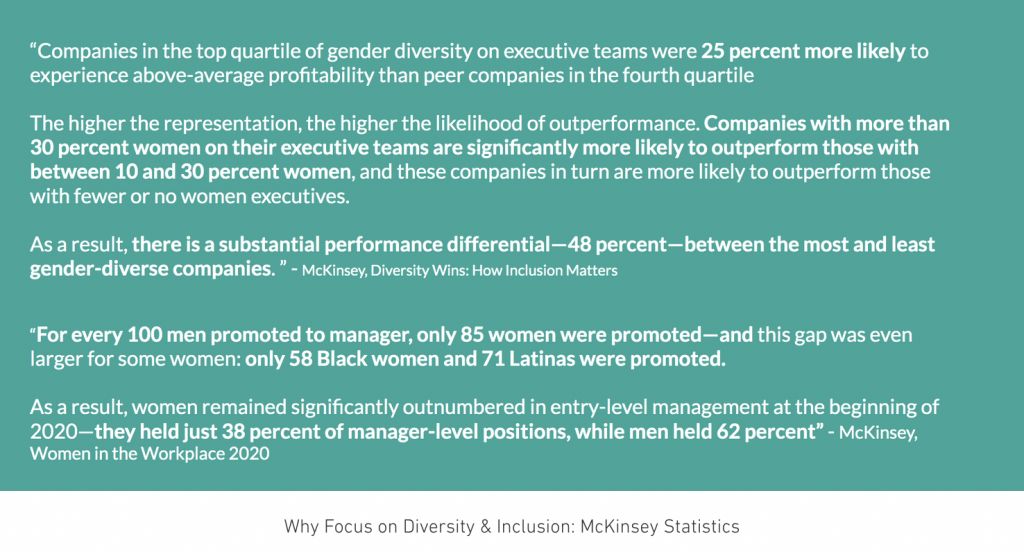
Driving Real Change Requires Re-Thinking How We Measure Diversity & Inclusion Progress
There are common accusations for organizations paying lip service to D&I – hiring diverse talent mostly at the lower rungs of the organization, putting one woman on the board, one-off Diversity & Inclusion trainings – you know the drill.
Most organizations are still unable to identify potential blockers and biases keeping diverse talent from moving up the organization once hired – or helping diverse talent move beyond the middle management chasm.
As we move towards a world where reporting on, and even disclosing, Human Capital and ESG Metrics becomes a requirement, organizations have a choice: “Do we continue to live up to inadequate standards for Diversity & Inclusion- purely for the sake of compliance, or do we focus on building a culture of Diversity, Equity, Inclusion and Belonging as a Strategic Advantage?”
As an example, the Diversity and Inclusion reporting standards as listed under the ESG disclosure recommendations ( by the World Economic Forum and IBC completely fails to go beyond surface-level vanity headcount metrics, and fails to even include anything to do with advancement or inclusion!
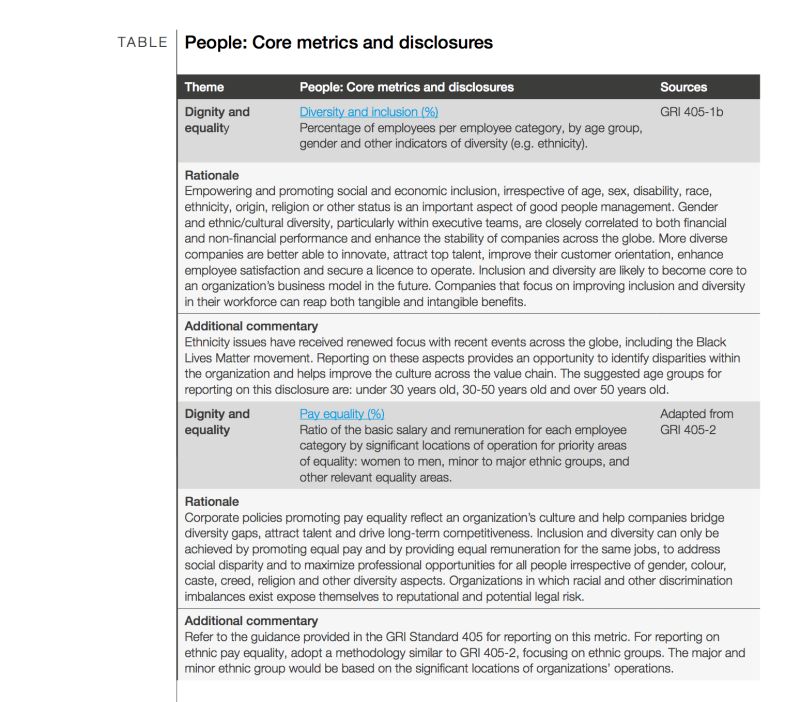
Data Democratization: The Need for Transparency
Given we now live in a world where the employer brand and consumer brand are becoming increasingly intertwined, and the rise of consumers/ retail investors and younger employees who’re extremely sensitive to societal ESG issues, building successful and sustainable Diversity, Equity, Inclusion and Belonging (DEIB) programs is now table-stakes for organizations, not just for attracting, engaging and retaining top talent, but also an issue which can have a direct impact on stock value, as has been made apparent in the wake of certain recent events.
Diversity data has traditionally been made available to just HR teams and Senior leadership, who’ve shied away from sharing data and controlling access, or on the extreme end of the spectrum, not even track D&I data, “It’s not a problem if we don’t know it exists”. This top-down approach is and has been highly ineffective in building a truly diverse and inclusive culture.
As companies attempt to approach DEIB with an intersectional lens, making the organization’s progress on improving Diversity & Inclusion visible to employees also helps build the trust required to disclose non-mandatory Diversity data. This approach works best when coupled with clear People Analytics Ethics Guidelines detailing what analyses employee data will and will not be used for.
While Diversity and Inclusion needs a top-down leadership-led approach, a lot of the interventions are bottoms up involving day-to-day interactions b/w managers and teams. It doesn’t help that in most cases managers might be unaware of their own biases and providing tools to managers to be able to understand their behaviors and course correct is key to the success of DEIB initiatives at a grass-roots level.
According to TI people’s “The State of Employee of Employee Experience 2020” report, an employee’s experience with their managers is amongst the most influential in driving an improved Employee Experience. The growing popularity of Employee-Experience(EX) centric companies is juxtaposed with the steady shrinking of HR headcount over the past decade, so it has been increasingly necessary for People Analytics to focus on empowering managers and HR Business Partners with insights into where and how they can improve daily People Management decisions, rather than using People Analytics as a purely strategic decision-making tool.

Consequentially, it is of utmost importance to empower managers to identify points of intervention and take action by giving access to relevant, timely people data and insights, and the same applies to providing managers with the tools to identify potential biases preventing your culture from becoming truly diverse and inclusive.
Our recommendation is for the D&I function to sit directly beneath the CEO if the CEO wants to highlight as a priority for the business, with the CEO communicating out the importance to his portfolio. This is what gave momentum to the D&I programs at several organizations including McKinsey, otherwise, D&I leaders face an uphill battle in getting priority and resources.
As for a diversity analytics function, which we predict will increasingly come to the fore in the coming years, we recommend this should sit within people analytics and report to the diversity leader, pretty much the same way recruitment analytics sits within people analytics but reports to the head of recruitment.
A Pressing Need For Practical People Analytics
First, a disclaimer: Data doesn’t tell you how to solve a problem but helps you ask more questions and raise awareness. Sometimes just knowing a data point is being tracked makes people behave differently and this is even more helpful when people can see the actual data and outcomes to know how the organization is responding to mitigating systemic biases.
To reach the aforementioned level of data democratization, companies need to embed people analytics at the core of their daily people decisions, rather than People Analytics teams just focussing on one-off strategic pieces of analysis.
Practical People Analytics (Consistent, Connected, Accessible and Repeatable) enables stakeholders across the organization to drive business performance & reduce bias through data-informed people decisions.
Getting down to a granular level is important to identify real problems – blanket interventions might be unnecessary or counterproductive – leading to a feeling of antagonism or a waste of time with managers.
This leads to more criticism and backlash when people see pledges for change but real change is not happening- democratizing access to the results and progress of D&I initiatives can be a game-changer for winning over your employees to actively partake in ensuring your organization is promoting a culture of Diversity, Equity, Inclusion and Belonging; especially when used to celebrate success by identifying and recognizing managers who are doing well.
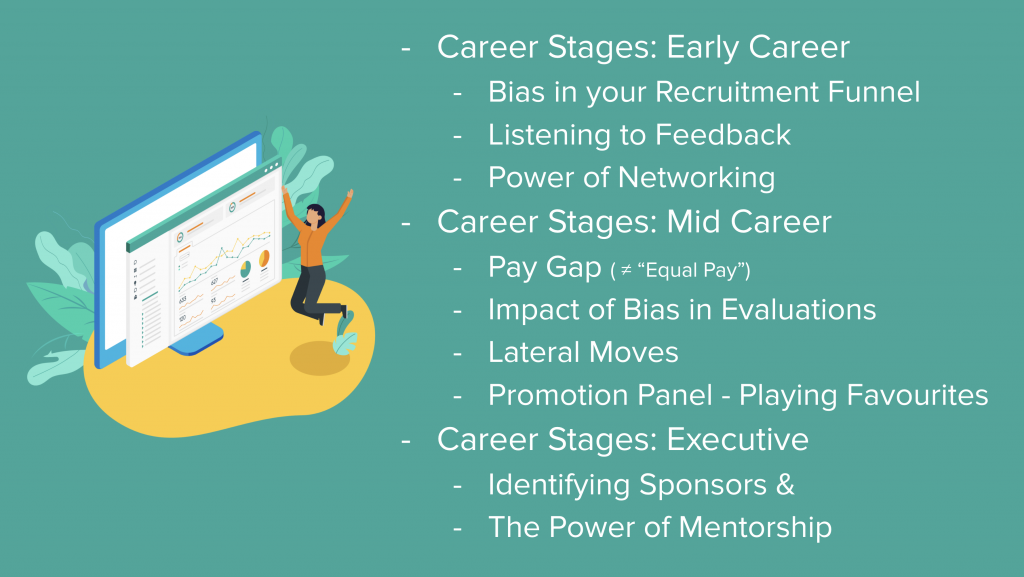
Identifying Bias in Your Recruitment Funnel
Breaking down your recruitment funnel by each stage of the funnel, along with other dimensions such as recruiter, hiring manager, department, geography etc. allows you to identify where the real challenges are in hiring diverse talent.
For example, If your recruitment funnel doesn’t match with your desired 50:50 gender ratio, is this because you can’t attract a 50:50 gender ratio, or is it due to a disparity in the screening process? If the former, which sources have historically attracted more women, and can you invest further in those sources? If the latter, can you investigate why diverse talent is being rejected in your screening processes?
Candidate and employee onboarding experience surveys can be an incredibly powerful tool when layered upon the areas of potential bias uncovered through quantitative analysis to understand why people are dropping out and which parts of the process people drop out due to a bad experience in the recruitment or onboarding phase.
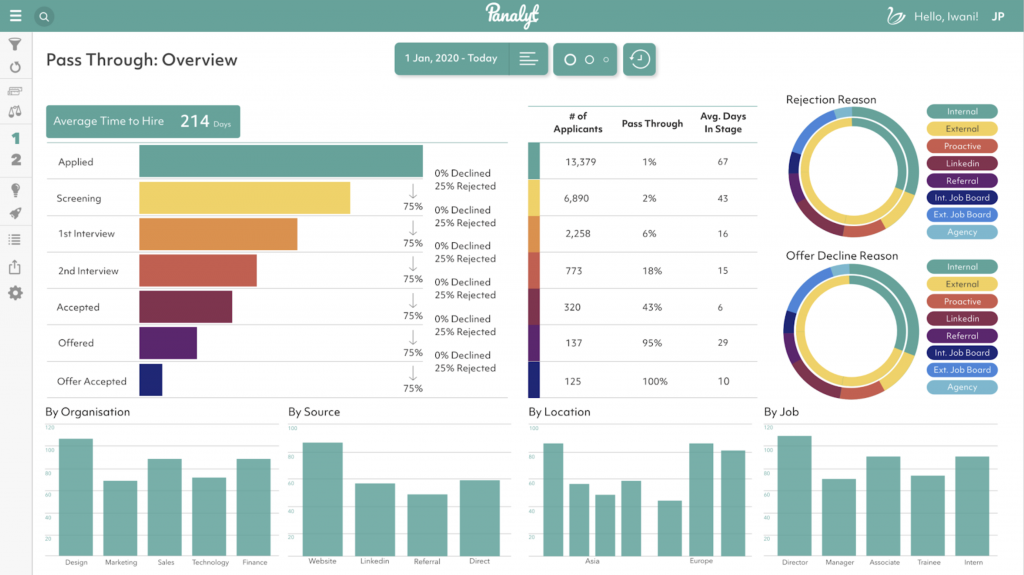
A common issue when analyzing recruitment data is that organizations don’t track the gender of the candidate and only the gender of the hired candidates, leading to a misleading analysis when the success of your recruitment team’s Diversity & Inclusion efforts is just based on hires.
We recommend that while many companies and countries don’t have an absolute requirement to capture diversity data in the recruitment phase, companies should still try to actively capture as much diversity data as possible while keeping certain diversity fields opt-in.
There is a widespread expectation on the candidate side that there will be bias, so companies should be explicitly clear on why they need the data to eliminate bias and include processes that ensure the data is disclosed only for later analysis and won’t be disclosed to people involved in the screening and recruitment processes.
A suggestion from us is to ensure that diverse candidates are able to meet with a diverse pool of people during the recruitment process, This might not necessarily mean that someone should interview with someone from the same demographic, but just having a buddy to help prepare for the final interview can sometimes really make the difference in your candidates feeling included.
Leverage Organizational Network Analysis As A Means To Objectively Measure Inclusion
The accelerated shift to remote and hybrid work models has led to a consistent C-level concern: ” Are employees effectively building relationships in a virtual environment?”
There’s always been a major gap in understanding how work really gets done at an organization. Org charts / org designs are hypothetical in nature and don’t give you the ground reality on how people are actually collaborating.
Organizational Network Analysis(ONA) enables you to measure the strength of employee and customer relationships by mining behavioral insights from communications and collaboration data.
Amongst other use cases around improving employee productivity, innovation, and wellness, ONA can also be an incredibly powerful tool to identify exclusionary cliques hindering your DEIB efforts.
More specifically Employee Onboarding, ONA helps you see how employees build relationships during onboarding and this helps you ensure employees from diverse backgrounds are integrating into the organization.
Stronger relationships formed early in the career have a direct correlation with the chances of employees succeeding in their roles and moving upwards in the organization – and the ONA data allows you to structure interventions and more effective mentorship/ buddy programs to integrate new hires into the organization through connecting them to highly networked individuals in the organization.
“Individuals with a higher connectivity/relationship score were more likely to report higher job satisfaction, perform better at work, and be more productive. Workers with higher connectivity scores were also more likely to stay at their current company longer.” – Zoom Video Communications, Australia Connectivity Report
If a predominant population is identified as isolated, a company can consider setting up Employee Resource Groups to connect people from similar backgrounds, or might share similar interests or be passionate about a common cause.
While at first glance, this might seem to reinforce silos – using ONA can also help you ensure that the ERGs can be connected to highly networked people within the organization to improve visibility and influence within the organization.
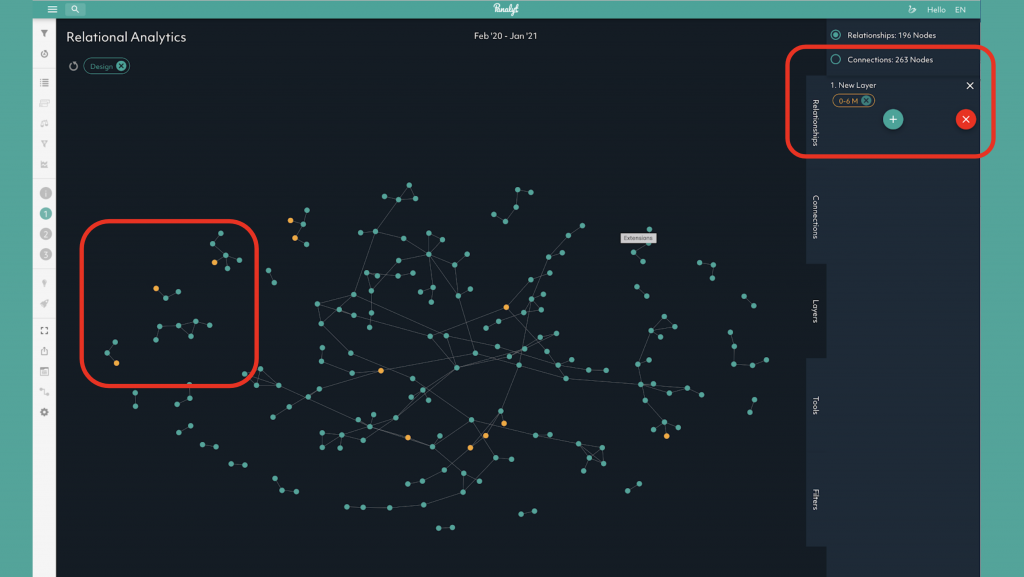
ONA also helps you understand if people are building networks inside their teams or diverse networks across different teams, locations, and grade levels, i.e. the dynamics of how employees socialize within and across teams, allowing you to identify projects that give exposure and identifying areas to improve the cross-pollination such as giving them projects that give them exposure.
A major global Japanese conglomerate working with Panalyt was able to include new hires in Japan on global projects and identify areas of intervention where new hires needed help with successfully collaborating in a distributed environment.
Don’t Confuse Pay Gap Analysis with Equal Pay
A common mistake when doing pay gap analysis is not going granular enough to get the point of being able to look at equal pay.
Digging into your salary data at a more granular level to look at comparisons for populations across similar roles, departments, geographies, and job grades. allow you to identify disparities in pay that might be hidden when just reporting on a blanket pay gap number.
For example, looking at the Gender Pay Gap for different groups can lead to wildly different numbers, as compared to your organization’s Overall Gender Pay Gap, which could mean that your organization might be missing out on insights and points of intervention that might be ignored when a blanket intervention is applied.
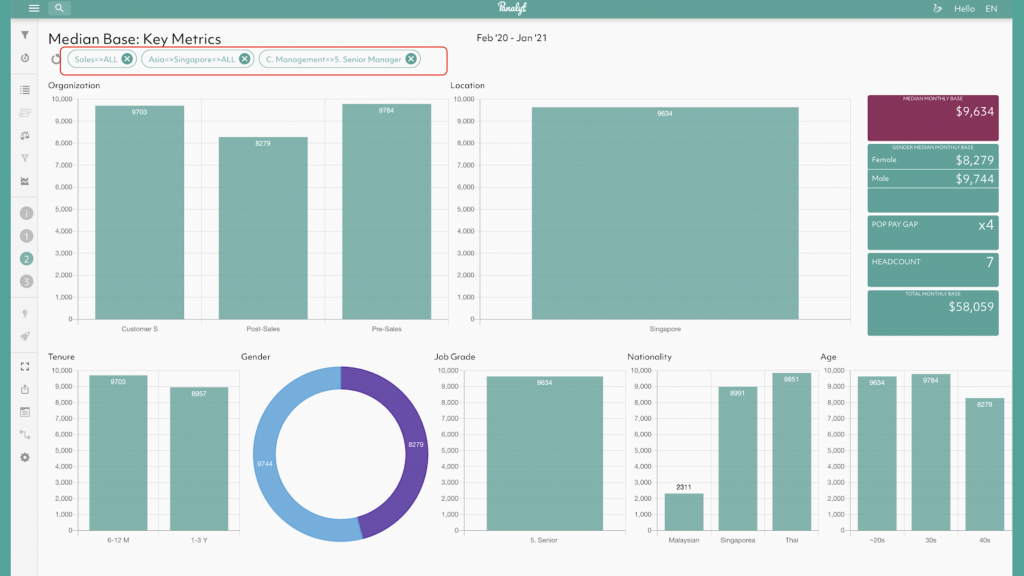
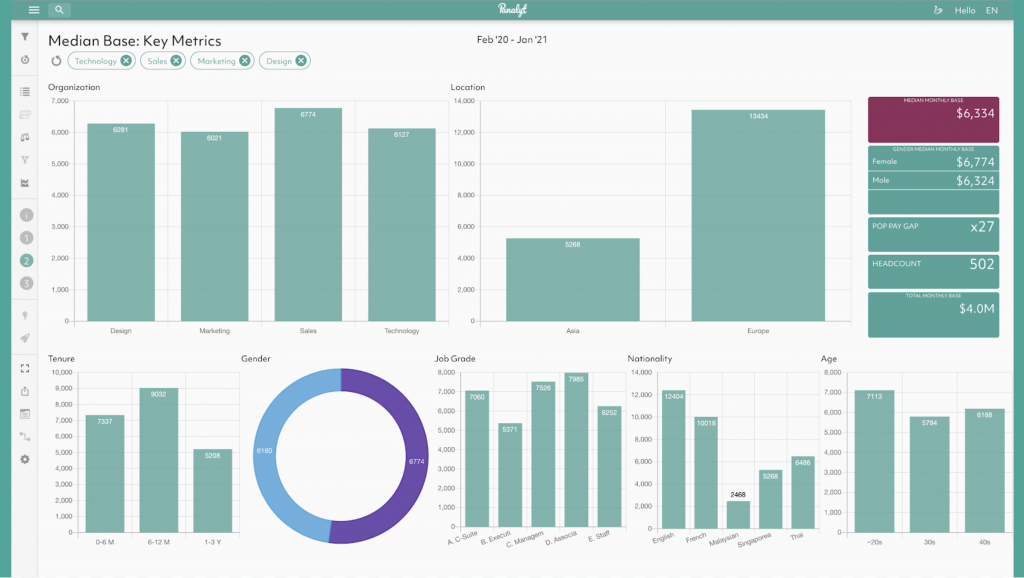
Internal Compa Ratios can also be an incredibly effective tool for looking at how diverse employees are being compensated as compared to their peers in similar roles, departments, geographies, and job grades.
In fact, we at Panalyt observe that a disparity in how employees are compensated as compared to their peers is often a much stronger driver for attrition, as compared to market compensation comparisons.
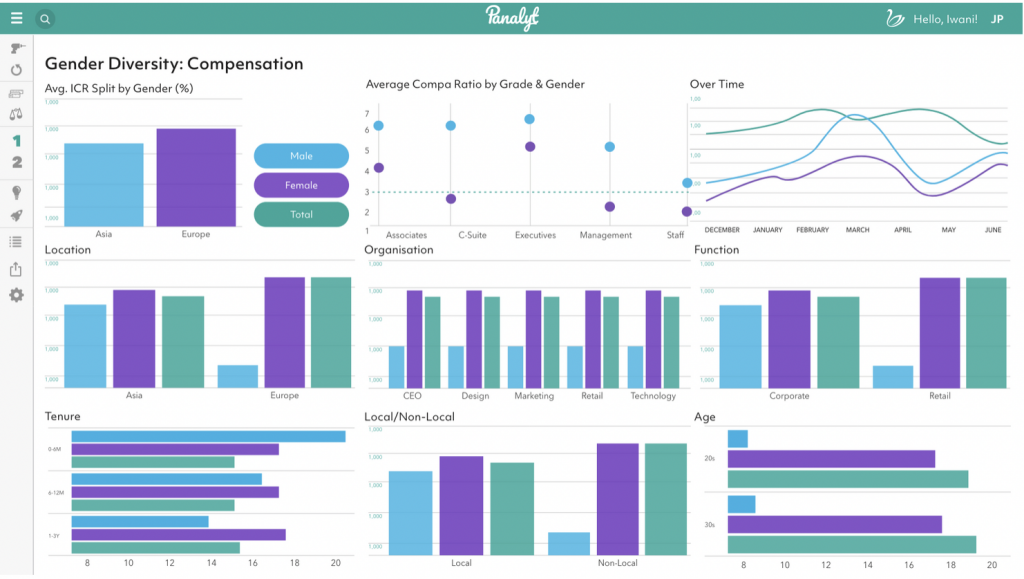
Uncovering Biases in Performance Evaluations
While most companies don’t segment performance data by a demographic basis due to the complexity of the analysis, looking at the distribution of evaluation grades across groups, for example, men vs women might help you uncover if a certain population might have a performance distribution curve disadvantageous to the average baseline or more privileged demographic groups.
For example, in our experience working with a geographically distributed ride-sharing organization, we uncovered that a general disparity in performance distributions didn’t exist at the org level, but for one specific country, there was a huge disparity where out of 500 people there were no women in the first quartile performance in the whole history of the organization.
This then opened the door for looking into why the women were not being hired and if there are any systemic issues with the performance evaluation process keeping women from progressing in that country.
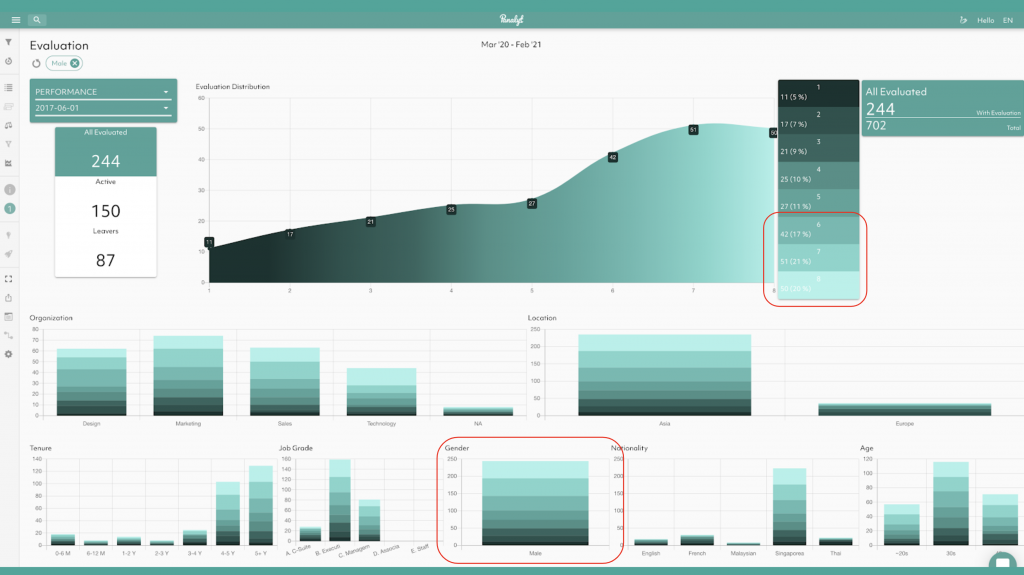
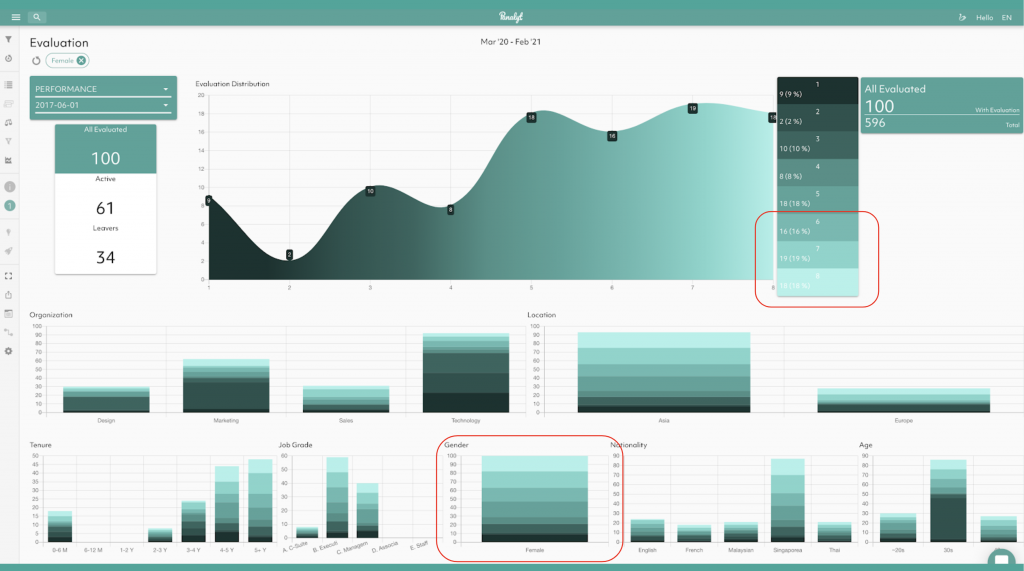
Segmenting the results of your Performance Appraisals in such a manner brings systemic issues hindering the advancement of diverse talent front of mind, allowing managers to make decisions with more consciousness and pause to see if there are any biases in how they’re awarding performance grades.
Another issue is to think about who’s in succession plans and talent programs – someone who doesn’t show leadership in the way we expect but might still have a high impact on the organization.
Identifying “hidden enablers” or “hidden stars” who might not be evaluated as high performers under traditional performance evaluations, but play an important role in enabling high performers and connecting them with the right people and resources internally at the right time, allows you to recognize and reward individuals who are having an invisible positive impact on your business.
“Connector managers elicit performance by connecting employees to the right people and resources at the right time. In doing so, Connectors boost employee performance by up to 26% and more than triple the likelihood that a coached employee will be a high performer; their performance impact is head and shoulders above any other manager approach. Connectors also boost employees’ discretionary effort, engagement and intent to stay — all critical outcomes for enterprise performance.” – Gartner, The Connector Manager Performer Advantage
Analyze Historical Attrition and Predictive Attrition Risk Patterns To Identify Where & Why Diverse Employees Have Left or Might Leave Your Organization
While easily analyzing historical attrition patterns to understand where and why employees from under-represented groups are leaving the organization still remains a challenge for a lot of organizations we speak with at Panalyt, this is an absolute must-have to be able to objectively identify potential barriers leading diverse employees to leave your organization – especially when viewed alongside the aforementioned historical promotion pipeline analysis.
We recommend segmenting your attrition analysis by Regret/ Non-Regret Attrition ( do we regret the employee leaving or not?), Voluntary/ Involuntary ( did the employee leave of their own accord or were they terminated?), and different time buckets ( for example, 3 Month 1 Year and Total Attrition) that are most suited to your organization’s talent processes.
Integrating Attrition data with Employee Experience/ Employee Engagement survey data enables you to understand why diverse talent might be leaving your organization; while integrating Attrition data with Performance and Productivity data ( and data on your historical promotion pools if available) allows you to understand where you’re losing diverse talent who would have been eligible for advancing further up the organization.
Leveraging Predictive Attrition Risk Algorithms can also help organizations identify where they might potentially lose employees from under-represented groups and uncover potential factors for why the employee has been categorized as a high flight risk, allowing HR and managers to schedule the necessary interventions to retain diverse talent.
A caveat to using machine-learning algorithms based on employee data is that based on your intended use of the output of the algorithm, you might want to take a further look into whether the algorithm might be further propagating existing biases in your dataset.
Mitigating Favouritism Bias in Promotion Decisions
According to McKinsey, women are 1.2x more likely than men to cite acute difficulties with fair performance reviews. LGBTQ+ respondents are 1.4x more likely than straight and cisgender employees to cite acute challenges with fair performance reviews (and workload increases and are struggling similarly with a loss of workplace connectivity and belonging).
It is implicitly understood that whom employees know in the organization, how they build relationships within the organization, plays a major role in their progress upwards in the organization. While Inclusion is tricky to define, a particular aspect answered by Organizational Network Analysis is – “Do employees from underrepresented groups have the same access/ relationship to senior colleagues/ managers as compared to other colleagues in the same job, at the same level and tenure? Does diverse talent get the access/ mentoring that will develop their careers and give them senior visibility?” Organizational Network Analysis provides a means to analyze the link between an employee’s network in the organization and the chance of getting promoted- and intervene accordingly to help them build those relationships within the organization. Looking at the relationships between the population eligible for promotion and the members of the promotion panel, and how much previous relationships influence promotion decisions allows you to uncover potential favoritism biases in your promotion processes.
While an employee having an existing relationship with members on the promotion panel might not necessarily be a negative issue, the possibility of a promotion decision being biased is an issue organization should be aware of when trying to understand if diverse talent is being given a fair chance to be promoted and move upwards in the organization.
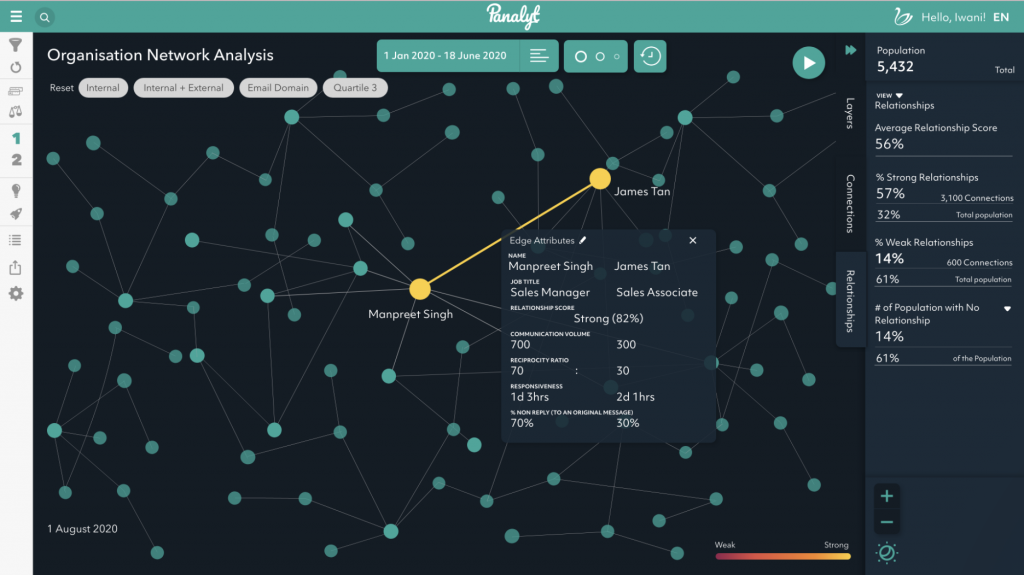
Organizational Network Analysis also helps you understand how to support diverse candidates to build these networks before they get to a promotion situation, or alternatively explore ways to broaden the promotion panel to have more objective stakeholders who might not sit in the department but understand the role and are stakeholders in the process.
A simpler application of People Analytics to improve the advancement of diverse talent would be to analyze your promotion process history in the same manner as you would analyze your historical recruitment funnel, by looking at metrics such as the pass-through rates between job grades and average time in job grades for different demographic groups. Doing this enables you to understand if there are certain managers, departments, or geographies under which diverse talent cannot move beyond middle management and advance into the senior ranks of the organization.
Even looking at whether your pool of internal promotion candidates is diverse enough to support your organization’s long-term diversity goals can help you understand if you need to reassess your promotion criteria to make it more inclusive, or if you absolutely need to hire diverse talent externally to hit your desired diversity targets.
An additional recommendation from us on improving the chances of diverse talent moving up your organization would be to ensure that your promotion pools are diverse as well. The Harvard Business Review article “If There’s Only One Woman in Your Candidate Pool, There’s Statistically No Chance She’ll Be Hired” deep dives into how the diversity of your promotion pool has a direct impact on who actually ends up getting promoted.
Improving Internal Mobility and Lateral Movements For Diverse Talent
Internal mobility can be a major contributor to later success in the organization. As part of most successions, especially at more senior levels, promotions look at people who’ve experienced different parts of the organization and can use their greater organizational knowledge to support the growth of the business.
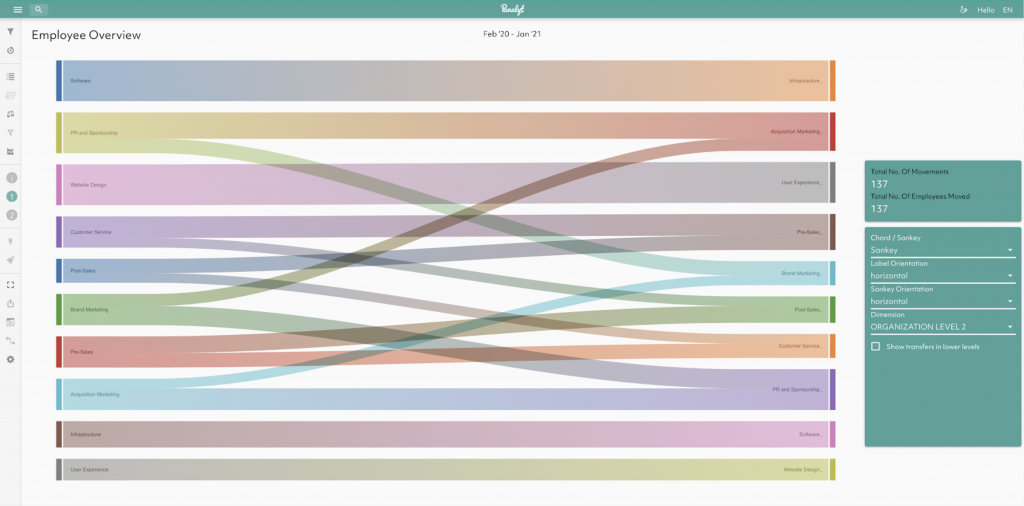
A major issue, especially when considering gender, is that a lot of women in senior roles don’t end up in line roles but instead end up in functional roles like HR, Finance instead of the head of business for more revenue-generating parts of the business.
Analyzing lateral moves can help you uncover if there are any systemic biases keeping diverse talent from moving towards functional roles, which might be a personal choice sometimes, but keeps managers and employees aware of their decisions and how this can affect their careers – especially when analyzing from a broader career perspective – for eg. looking at senior executives to see where senior executives are coming from within the organization and how they navigate their way internally through the ranks.
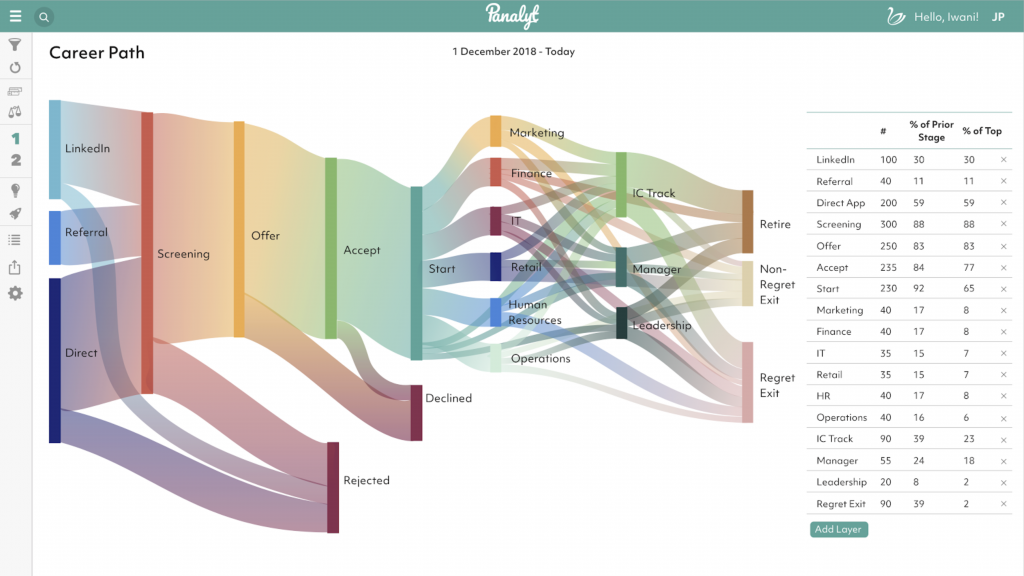
Embed a D&I Focus Into Your Employee Listening Strategy
Frequent pulse and micro-pulse surveys have now become the norm for assessing the Employee Experience, and it is important to look beyond company/ department/ location averages and segment the results of your surveys by different demographic groups in your organization to identify particular issues being faced by under-represented talent.
Correlating these insights with attrition, productivity, and performance data can help you understand why diverse talent might be leaving your company, or if certain cultural issues might be hindering the performance of your diverse employees.
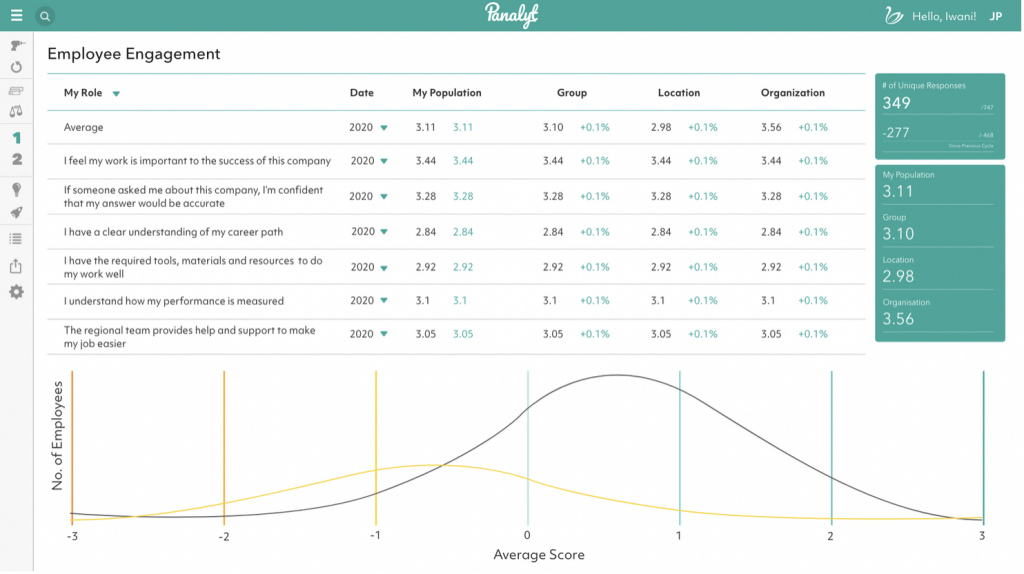
Taking this one step further – while survey tools are improving their Natural Language Processing abilities, there is still no substitute for 1:1 or smaller group conversations with a focus group of employees to understand the root cause of their issues. This becomes increasingly difficult to do at scale as the widespread trend of companies rapidly shrinking their Human Resources headcount continue.
Organizational Network Analysis can help you uncover “connectors”, along with other organizational influencers, within your under-represented population, or people who have relationships with a wide group of people within (and outside) a certain community who would be able to provide a birds-eye view into the problems being faced by a certain group of employees, and would be ideal candidates for focus interviews under your Employee Listening strategy.


Drive Change Through Organizational Influencers
Transforming your organization’s culture into one that promotes Diversity, Equity, Inclusion and Belonging, can be seen, in essence, as an enterprise-wide change initiative.
However, more than 70% of organizational change management process initiatives actually fail to meet their goals, mostly due to complications arising in the execution and the adoption phase – it’s clear that the conventional top-down approach where companies attempt to spread change as if spreading peanut butter on toast doesn’t work anymore.
Identifying organizational influencers for successful change management and transformation is a very intuitive application of Organizational Network Analysis, especially given how frequently we come across influencers on social media.
In the same way that companies leverage influencers/ micro-influencers to accelerate go-to-markets, drive revenues & brand recognition, companies can leverage Organizational Network Analysis to identify which individuals can be leveraged as change agents to influence/nudge their peers to drive the adoption of the desired change in a hyper-targeted manner– the change initiative in this case being promoting the values required to build a truly diverse and inclusive culture.
Stealing an example from Crossing the Chasm by Geoffrey Moore –Imagine if you could spread change similar to how the Allied forces invaded and won against the Axis in WWII.You know where you want to spread change ( where you want to invade) but to achieve this you first identify your influencers ( your beach-head at Normandy) & from here you strategically expand across the organization by leveraging their influence to get people on-board aligned with your desired change goals ( win neighboring territories) until you finally achieve your goal of organization-wide change and transformation.
Helping Employees From Under-Represented Groups Navigate Through COVID Induced Shifting Work Patterns
Whilst the shift to remote/hybrid work has been largely accelerated due to the COVID-19 pandemic, we see this as a long-term trend that is here to stay. Several norm-setting organizations have long-term plans to allow employees to work remotely and this will clearly evolve and spread.
Unfortunately, women employees and employees from minority/underrepresented groups have been disproportionately affected by the sudden shift to remote work, with Mental Health, Connectivity & Belonging, and Workload Increases being amongst top concerns.
An executive study by the IBM Institute for Business Value and Josh Bersin found Employee Mental Health / Burnout is amongst the top challenges cited by C-Suite executives that their business will face in the next 2 years.
According to McKinsey, women are 1.5x more likely than men to cite challenges pointing to a “double shift”: acute challenges with mental health and increased household responsibilities.
This difference in mental-health issues is even more profound in the United States and the United Kingdom, where women were 2.6x and 2.9x respectively more likely than their male counterparts to report acute challenges with mental health issues.
The same study also found 2/3 LGBTQ+ employees reported either acute or moderate challenges with mental health.
Where traditional people management techniques based on observations in the workplace become obsolete, it is increasingly important to empower HR and line managers with the tools to understand, influence and improve the Remote Employee and Manager Experience.
Relational Analytics empowers companies to diagnose potential problem areas in the remote Employee Experience and identify where necessary interventions are required to take a pro-active approach towards employee wellness, rather than always reacting and putting out fires.
This empowers companies to diagnose potential problem areas in the remote Employee Experience and identify where necessary interventions are required to take a pro-active approach towards employee wellness, rather than always reacting and putting out fires.
Collaboration Analytics, a subset of Relational Analytics, can be incredibly powerful for identifying employees at risk of burnout/ collaboration overload. Enabling HR & managers with the tools to understand changing work patterns for their remote teams allows them to recognize irregularities in increased after-work hours collaboration activity, along with understanding patterns in the volume of communications and the time spent in meetings.
For example, a manager can identify if an employee is not getting enough flow time between meetings during the week to do focussed work and coach the employee to change how they schedule their meetings or adjust the employee’s workload accordingly.
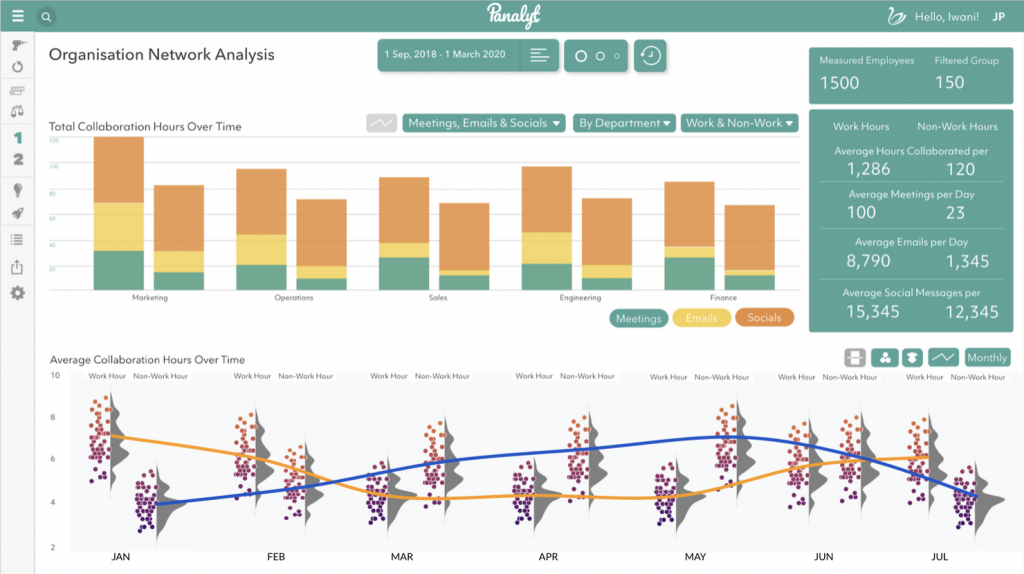
Concluding Thoughts
We at Panalyt believe that bridging the people data gap and ensuring access to timely and relevant people data and insights across the employee lifecycle, made available to stakeholders across the organization, is the key to proactively identify risks and areas of interventions hindering the progress of your diverse talent across the employee experience.
Knowing the real progress and success of your organization’s DEI efforts not only helps the business but also influences your employees to contribute to the cause, allowing you to organically build a truly diverse and inclusive culture and by extension enhance your employer brand, allowing you to hire, develop and retain talent from all backgrounds and giving them an equal chance to succeed in your organization.
If you felt that this article was insightful to you and your peers can benefit from it too, we’d love it if you shared this with your network!
About Panalyt
Panalyt bridges the People-Data Gap, enabling real-time, uniform access to relevant people data, reports and insights for CxOs, HR, and business managers.
People data, including employee interactions and connections is combined with business data empowering businesses to leapfrog to data-driven decision making, eliminating bias and improving engagement, sales effectiveness, productivity and, as a result, business performance.
Interested in a further discussion on how People Analytics and Relational Analytics can help you drive an improved employee and business outcomes? Book a 30-minute discovery call with our Panalyt co-founders to learn more!






